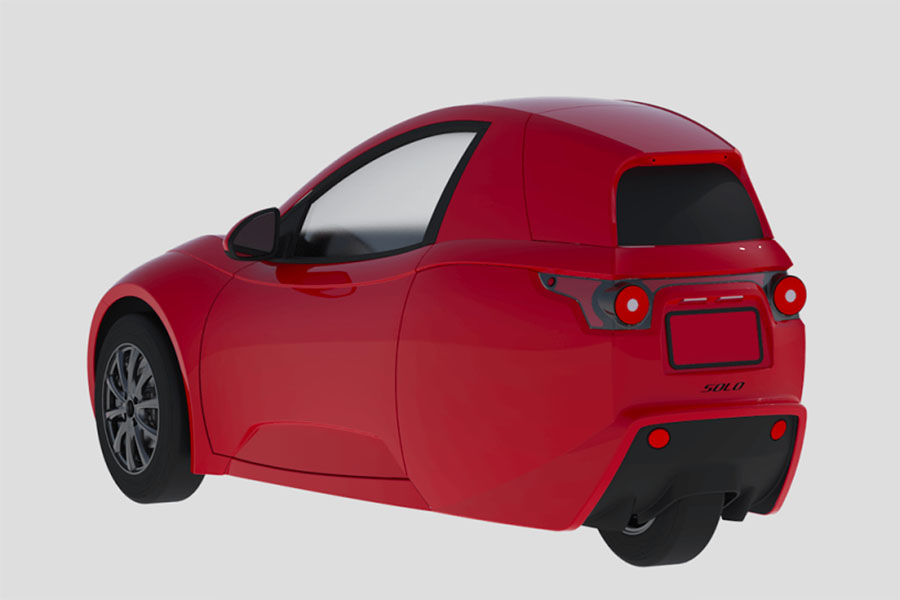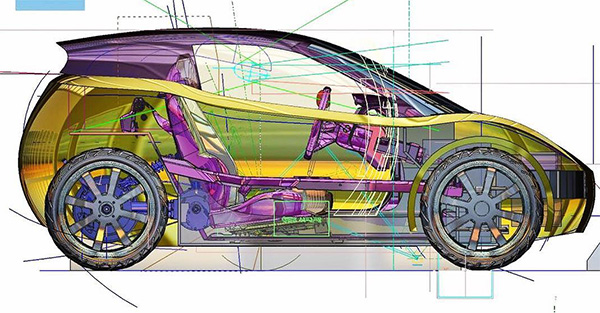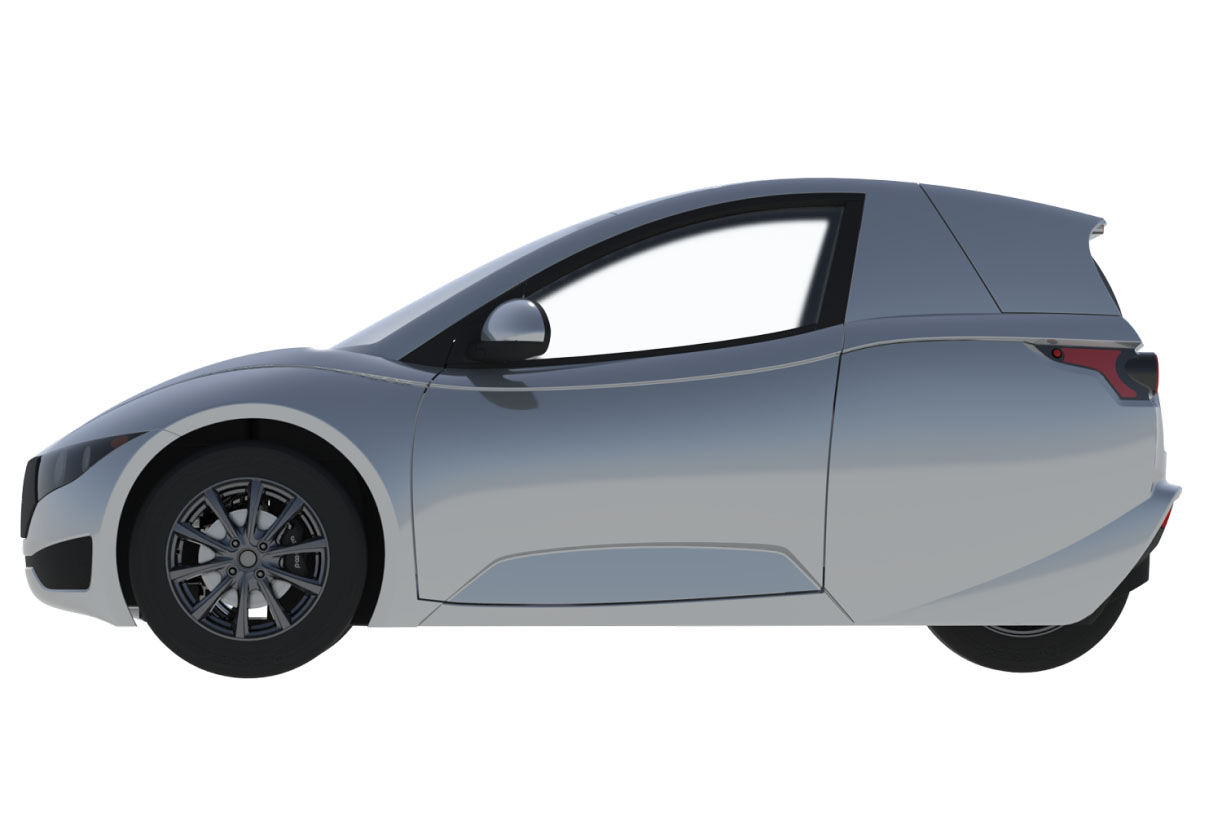There was a day in October, 2012 when Vancouver’s Jerry Kroll, then 52, saw something in Fremont, California that came as revelation. With a background in high-octane NASCAR auto racing and, oddly, an equally compelling entrepreneurial interest in building an electric vehicle for urban commuters in B.C., Kroll and an automotive friend, Henry Reisner, arranged a tour of the vast Tesla Motors assembly plant located south of San Francisco. They saw 160 huge, German-made robots – with X-Men names like Wolverine, Cyclops and Iceman – operating on an automated, ultra-modern assembly line that required little human involvement. They saw windshields affixed and 540 kilogram lithium-ion batteries being installed, all robotically.
They watched the finished $100,000 Tesla Model S electric sedans silently roll out of the 1.5 kilometre-long plant, all pre-sold.
The two were agog. They saw the future: North American car manufacturing was not necessarily dead; but Detroit’s carbon-spewing gas-guzzlers were, they understood, doomed. With the latest technology, imagination and Tesla CEO Elon Musk’s money, the impossible – creating a non-polluting, electrically-powered vehicle – was possible.
“Can we do this? Reisner asked.
“We can do this,” Kroll replied.
The “this” in their discussion was revolutionary. For five years previous, they’d been investigating the engineering and economic potential of creating a small electric vehicle meant for urban commuters. They’d looked at the Renault Twizy, but found it little more than an advanced golf cart that can’t operate on highways. They’d studied the California-designed Corbin Sparrow, a three-wheeled, jellybean-shaped EV, but discovered it had serious design and engineering faults.
Returning to Vancouver that fall, Kroll and Reisner decided they needed to create an entirely new vehicle. It would be a one-passenger, highway capable EV, and be marketed toward the 83 per cent of drivers who commute daily by themselves. Thus the name: Solo. Utilizing Reisner’s expertise as an automotive engineer at Vancouver’s 57-year-old Intermeccanica Custom Coach Builders, and with Kroll’s formidable chutzpah derived from running Ascend Sportmanagement, a marketing agency for celebrity athletes and race-car drivers, the two would carve out a unique space in the growing EV field. With Tesla holding the high-end sedan market, the $20,000 Solo would provide a solution for some of the 140 million commuters in North America who were prepared to Think Small.
“A single-passenger car fits an urban niche,” says Kroll, as he watches passing traffic outside his Quebec/East First Avenue showroom windows. “It might not turn heads at Ford and General Motors. It might not be the answer for everyone. But even if we sell it to one or two per cent of commuters, that’s still a lot of cars. It could be a very lucrative business.”

For the past three years, Kroll and Reisner and a crew of 20 automotive engineers, designers and mechanics have put shape to the somewhat quixotic vision of Solo. Operating out of a bleak industrial complex in New Westminster, with a budget of $3 million – about half of it Kroll’s – they have had to contend with the complexities of creating both an unusual product and brand, while struggling with – as Reisner puts it –- 'a lot of government lip-slappin.’”
The engineering challenges of building a fully-enclosed, 1.2 metre-wide by 2.7-metre-long, three-wheeled electric vehicle involves a fine balancing of choices. And a lot of prototype test driving and subsequent alterations. Safety requires the Victoria-made, carbon-fibre composite chassis can withstand accidents. But weight is the nemesis of electromotive batteries. (More weight equals faster battery use and less driving range.) So with each iteration of the Solo, weight has been shaved, and the lighter vehicle has now been joined with a new, made-in-B.C. lithium-ion battery that’s 30 per cent more powerful than previous off-the-rack ones. Solo prototype vehicles have a cruising speed of 110 kilometres/hour and a range of 160 kilometres on a typical three- to six-hour charge.
But as Kroll discovered in the last year, Solo’s most persistent nemesis has been government inaction – both provincial and federal. “I get ping-ponged between people,” he says, his voice shifting from annoyance to sarcastic mimic. “‘Oh, you should talk to the guy over there.’ And when you finally get to the guy over there, he says, ‘Maybe the guy over there could help out.’” And Kroll rolls his eyes. “Tesla got almost $5 billion from governments to get started in California. Here, bureaucrats think: if you do nothing, you can’t get in trouble.”
When Canada invented its own cars
Kroll understands that in a country built on resource extraction, grain and branch-plant thinking, a made-in-Canada micro vehicle, especially one that’s high-tech and runs on clean electricity, is a challenge to the country’s established economic interests. Canadian bureaucrats today may not know the names of early 20th century made-in-Canada cars – like the Brooks Steam Motors car, the Tudhope, or the Durant. All died when southern Ontario became a branch plant outpost of Detroit after the First World War. But everyone knows the name Bricklin. In 1974, the government of New Brunswick invested $20 million in the gull-winged sports car, promising that the vehicle marked the end of dependence on the province’s disappearing forestry industry and the start of a new industrial era for the Maritimes. The two Bricklin plants would produce 1,000 cars a month. Jobs! Good wages! Prosperity! However, just 2842 failure-prone Bricklins were built before the company went bankrupt in 1976. The word “Bricklin” became synonymous with government over-reach.
Kroll knows that buying into something new – even if it might help save the planet – takes foresight, conviction and money. That’s what happened in 2004 when American billionaire Elon Musk first got involved with an unknown EV startup and began plowing $70 million of his money into the Tesla electric car. These triple attributes – foresight, conviction and money – are what Kroll has been looking for as he has travelled the country trying to find investment interest to bring Solo to the Canadian public. But, he knows, even the most successful entrepreneurs don’t necessarily recognize a great opportunity. Jimmy Pattison, Kroll likes to say, admits his biggest mistake was declining the offer to acquire the Canadian Volkswagen Beetle franchise in the early '60s.
In a confident that-was-then and this-is-now assertion, Kroll says: “Solo’s going to be the VW Beetle for the 21st century.” If not a Pattison, or a Musk, or some Canadian investors or governments; there are others, elsewhere, he suggested this past March, who’ll embrace Solo, The time is right. And Kroll makes a nice analogy: “The first computers were desktops. Now it’s smartphones. The big, polluting, gas-guzzling cars are like desktop computers. Their time’s passing. People want convenience and mobility. Solo’s a sort of smartphone on wheels – small and portable. It’s a car you wear.”

Frustrated by endless – and fruitless – Canadian ping-ponging over the Solo project, Kroll and his Evans & Evans investment advisor, Mike Evans, headed to China in late March to pursue suggestions that companies there were interested in the vehicle. The Chongqing-based Zongshen Industrial Group is one of China’s largest corporations. It builds one million motorcycles a year, including Harley Davidsons for the export market and a line of open, one-passenger, three-wheeled, electric cargo vehicles; not too dissimilar from the Solo.
The two Canadians realized Zongshen was a good fit: expertise in three-wheeled electric vehicles, strong export savvy, and familiarity with partnering alongside western companies. So a memorandum of agreement was signed between Zongshen and Kroll’s Electra Meccanica –- with some production details left to further negotiations. “I can build 100 Solos a year in New Westminster,” says Kroll. “Now I’m working with a company that builds a million vehicles a year!” By January 2018, he expects 100,000 Solos will have rolled off the Zongshen assembly line, all destined for the Asian market.
Then – to compound this past spring’s good news for Kroll – what happened following the March 31 presentation of the new $45,000 Tesla Model 3 sedan made him almost delirious. Within three weeks of the Tesla 3 launch, over 400,000 people had plumped down US$1,000 each on pre-orders for an electric car that wouldn’t even be available until early 2018. The synchronicity of these events – both as proof of public concern over global warming, and as evidence of people’s willingness to invest in electric vehicles – could not have been more auspicious for Kroll. Solo would ride Tesla’s slipstream all the way to the bank. And, in doing so, would put humankind on the road towards reduced CO2 emissions.
Given these twin validations of Solo’s prospects, Kroll and Evans have begun work on taking Electra Meccanica public on the Toronto Stock Exchange. With his figures on the Initial Public Offering speculative and the outcome dependent on market reaction, Kroll floats some numbers for the September 2016 offering. “We list at, say, $10 to $20 a share. Our goal’s for it to rise to $100 a share. And raise $10 million, maybe $100 million in market capitalization. If it exceeds $100 million, we go to the New York Stock Exchange and raise 10 times that. And Solo’s an investment “unicorn.” “He knows it sounds incredible – raising $1 billion on a startup currently housed in an obscure garage in New Westminster, British Columbia.
“This is not a dream,” Kroll asserts. “People want it. The technology’s there. The only reason Solo’s not a $10-billion company is because my name’s not Elon Musk. No one knows who I am. I’m this company’s biggest liability. Everything else makes pitiful sense. It’s like [Steve] Jobs and [Steve] Wozniak in their California garage back in the '70s. ‘A what? A home computer? What’s that do?’ So... how’d that turn out? If you don’t believe in something, get a paper route!”
‘A David and Goliath situation’
It would be unfair to say the Greg Caws, the BC Innovation Council’s president and CEO, doesn’t believe in Kroll and his Solo. But, in Caws’ experience, he has several reasons investors might be wary. First, he explains, is the Early Adaptor Syndrome – an inventor’s belief that the initially enthusiastic few represent the cautious many. He mentions, as an example, the Segway personal scooter, once touted to be ubiquitous, as a classic case of over-sell. He underlines his concerns by explaining that venture capitalists, the ones who drop big money on IPOs, tend to be leery of relatively unknown startups. They’re looking for some serious return. And they know that every new product must face the assault of competition.
Says Caws of Kroll: “He’s in a David and Goliath situation. The large car companies will try to crush him. To succeed in innovation, you have to be a great future forecaster. You have to get it right. The only determinant of entrepreneurial success is tenacity.”
As the summer of 2016 passed and dealings with their Zongshen partners continued, Kroll and his automotive production supervisor, Henry Reisner, have been building Solos in the company’s cramped New Westminster facility. Using Solo sub-assemblies produced in Chongqing by Zongshen, and final assembly done in New Westminster by six mechanics working a 30-metre-long assembly line, Kroll predicts there’ll be 50 or so Solo EVs turning heads on North American streets by year’s end. All pre-ordered. Leona and Matt Green of New Westminster’s Greens and Beans Deli, for example, having pre-ordered a year ago, will get theirs right away. It will be used for a daily commute to the shop, the delivery of takeout orders, and an eye-catching prop parked outside their shop. Vancouver’s WA-2! water will get one soon, too, says its technical officer, Gary Bailey, because the non-polluting Solo fits the company’s ethical values. It will be used for business deliveries and equipment maintenance.
And Kroll claims he has another 9450 Solos – here and in Asia – pre-ordered as well. That’s $200,000,000 in pre-orders, all before a single operational vehicle has hit the streets.
If, as Caws suggests, you have to have the right idea at the right time, as well as the tenacity to make things happen, Kroll may well be sitting in the catbird seat. He’s got the world’s first, single-passenger, electric commuter car capable of highway speeds, and a lot of pre-orders. He’s got a clean technology vehicle when predictions call for a near-tripling of revenue – to $30 billion – for Canada’s clean-tech industries by 2020. And he’s got a partnership with an established Chinese mega-manufacturer.
“Detroit has spent billions on the internal combustion motor,” says Kroll. “They’re locked into oil. They’re a legacy industry. The 21st century is for the nimble. My job is to become Elon Musk.” ![]()
Read more: Energy, Transportation, Environment
















Tyee Commenting Guidelines
Comments that violate guidelines risk being deleted, and violations may result in a temporary or permanent user ban. Maintain the spirit of good conversation to stay in the discussion.
*Please note The Tyee is not a forum for spreading misinformation about COVID-19, denying its existence or minimizing its risk to public health.
Do:
Do not: